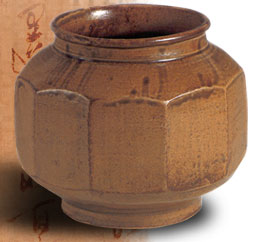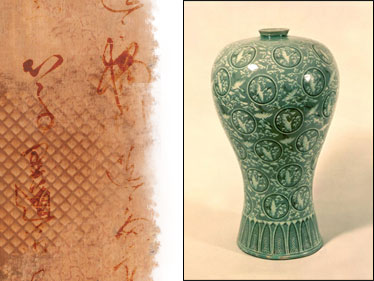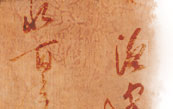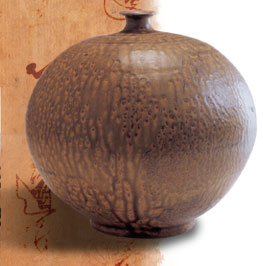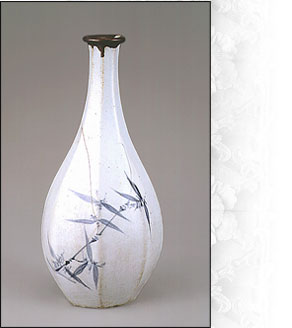 In the history of ceramics, Korean celadon porcelain of the Goryeo Dynasty is renowned for three very In the history of ceramics, Korean celadon porcelain of the Goryeo Dynasty is renowned for three very
 special and unique features. The first of these is the fabrication of the alluring jade-blue color Koreans special and unique features. The first of these is the fabrication of the alluring jade-blue color Koreans
 often called bisaek (‘kingfisher color’). Many art critics say that even with the advanced knowledge
often called bisaek (‘kingfisher color’). Many art critics say that even with the advanced knowledge
 of color composition in modern science, it is impossible to recreate the color’s graceful tone, hue
of color composition in modern science, it is impossible to recreate the color’s graceful tone, hue
 and elegance. Some go further, and declare that the color of Goryeo celadon porcelain is not just
and elegance. Some go further, and declare that the color of Goryeo celadon porcelain is not just
 a color but is the most divine state that any color can reach in terms of aesthetic beauty. The second
a color but is the most divine state that any color can reach in terms of aesthetic beauty. The second
 trait is the remarkable inlaying technique created by the Goryeo potters to embed wonderful and
trait is the remarkable inlaying technique created by the Goryeo potters to embed wonderful and
 graceful designs onto the surface of the ceramics, while the third characteristic is the use of oxidized
graceful designs onto the surface of the ceramics, while the third characteristic is the use of oxidized
 copper to decorate the surface of a ceramic piece. These achievements made great contributions
copper to decorate the surface of a ceramic piece. These achievements made great contributions
 to the development of the ceramic arts in Korea and the world. Some critics profoundly say that they
to the development of the ceramic arts in Korea and the world. Some critics profoundly say that they
 also helped Goryeo celadon porcelain move one step closer to art’s divine function of “purifying human minds
also helped Goryeo celadon porcelain move one step closer to art’s divine function of “purifying human minds
 with the power of beauty.” A great poet of the Goryeo Dynasty, Yi Gyu-bo, said that Goryeo celadon is made
with the power of beauty.” A great poet of the Goryeo Dynasty, Yi Gyu-bo, said that Goryeo celadon is made
 “by borrowing the magical power of heaven,” while his Chinese contemporaries praised it with expressions “by borrowing the magical power of heaven,” while his Chinese contemporaries praised it with expressions
 such as, “number one under heaven” and “extreme beauty.” Even today, many connoisseurs reveal their
such as, “number one under heaven” and “extreme beauty.” Even today, many connoisseurs reveal their
 admiration of Goryeo celadon works by calling them “blessings of heaven,” perfected by “God’s hands.” admiration of Goryeo celadon works by calling them “blessings of heaven,” perfected by “God’s hands.”


 Celadon Vase Inlaid with Crane-and-Cloud Pattern Celadon Vase Inlaid with Crane-and-Cloud Pattern
 Goryeo, 12th Century Goryeo, 12th Century
 42.1cm in height and 24.5cm in diameter at its widest point 42.1cm in height and 24.5cm in diameter at its widest point

 The voluminous form of this wonderful 12th century Goryeo porcelain The voluminous form of this wonderful 12th century Goryeo porcelain
 piece came from the Meiping (or Maebyeong in Korean, literally meaning piece came from the Meiping (or Maebyeong in Korean, literally meaning
 a ‘maehwa vase’) style from the Sung Dynasty in China. By the time this a ‘maehwa vase’) style from the Sung Dynasty in China. By the time this
 vase was made, however, Goryeo had already established its own style vase was made, however, Goryeo had already established its own style
 characterized by a more expansive form and elegantly-curved lines. An characterized by a more expansive form and elegantly-curved lines. An
 increasingly-important achievement of Goryeo porcelain ware in the increasingly-important achievement of Goryeo porcelain ware in the
 world’s ceramics history is the introduction of the inlaying technique to world’s ceramics history is the introduction of the inlaying technique to
 the art of porcelain. In this vase, whose form, size and luxuriousness the art of porcelain. In this vase, whose form, size and luxuriousness
 make it one of the greatest masterpieces of its kind, the pattern of white make it one of the greatest masterpieces of its kind, the pattern of white
 cranes and clouds is exquisitely inlaid into the surface of the jade-blue cranes and clouds is exquisitely inlaid into the surface of the jade-blue
 body. body.
 The Joseon Dynasty (1392-1910) introduced the era of white-ceramics production, but it also meant the emergence The Joseon Dynasty (1392-1910) introduced the era of white-ceramics production, but it also meant the emergence
 of Confucian culture in Korea. The Joseon Dynasty, launched after it forcibly overthrew the Goryeo Dynasty, attempted of Confucian culture in Korea. The Joseon Dynasty, launched after it forcibly overthrew the Goryeo Dynasty, attempted
 a great ideological shift in Korean society by promoting a ‘pro-Confucian and anti-Buddhist policy.’ The development a great ideological shift in Korean society by promoting a ‘pro-Confucian and anti-Buddhist policy.’ The development
 of white porcelain became an important part of the new dynasty’s efforts to lay a firm foundation for society to follow; of white porcelain became an important part of the new dynasty’s efforts to lay a firm foundation for society to follow;
 the simple and austere white ceramics ware matched the Confucian ideals of a simple and austere lifestyle. Gradually the simple and austere white ceramics ware matched the Confucian ideals of a simple and austere lifestyle. Gradually
 white ceramics ware grew to symbolize the Joseon Dynasty that ruled the kingdom according to Confucian
white ceramics ware grew to symbolize the Joseon Dynasty that ruled the kingdom according to Confucian
 teachings.
teachings.
 The white ceramics of the early Joseon Dynasty display an ascetic yet regal beauty, as if to reflect The white ceramics of the early Joseon Dynasty display an ascetic yet regal beauty, as if to reflect
 the artistic taste of Neo-Confucian scholars who sought after a strictly-disciplined mind and an immaterialist
the artistic taste of Neo-Confucian scholars who sought after a strictly-disciplined mind and an immaterialist
 philosophy. Consequently, these pure-white ceramics without any decoration became mainstream,
philosophy. Consequently, these pure-white ceramics without any decoration became mainstream,
 although some were adorned with delicate and fine literati ink painting in blue and/or oxidized iron.
although some were adorned with delicate and fine literati ink painting in blue and/or oxidized iron.
 In the mid-Joseon period, white ceramic artisans in Korea began to produce some of the finest
In the mid-Joseon period, white ceramic artisans in Korea began to produce some of the finest
 porcelain in terms of stark beauty, perfect balance and elegant form closely interwoven with profound
porcelain in terms of stark beauty, perfect balance and elegant form closely interwoven with profound
 philosophical thoughts about nature. By the time the Joseon Dynasty had moved into its later period, philosophical thoughts about nature. By the time the Joseon Dynasty had moved into its later period,
 the porcelain had also evolved towards the ‘beauty of daily life,’ by focusing on practical usage with
the porcelain had also evolved towards the ‘beauty of daily life,’ by focusing on practical usage with
 more decorativeness. By this time, the use of porcelain had spread into the life of the common people and
more decorativeness. By this time, the use of porcelain had spread into the life of the common people and
 the ceramics, themselves, had transformed into incredibly modest yet delightfully versatile household items.
the ceramics, themselves, had transformed into incredibly modest yet delightfully versatile household items.
Blue and White Porcelain Bottle with
Chrysanthemum and Bamboo Design
Joseon, 18th Century
27.5cm in height and 12.8cm in diameter at its widest point.
This blue and white porcelain bottle of the Joseon Dynasty displays
an elegant octagonal body, sleek neck and a charming lip gently curled
out. Its delightfully-simple form, slightly bluish-white color, and refined
chrysanthemum and bamboo design painted in restrained blue makes
this a wonderful example of blue-and-white ceramic ware of the mid-
Joseon period. With its charmingly-small size, unassuming color
combination, and serene form, this bottle is widely regarded as a
masterpiece of its kind.
One of the major production sites of ceramic ware made for the masses during the late Joseon Dynasty was the
city of Mungyeong located in the southeastern part of the Korean peninsula. Here more than 200 kiln sites have been
found and the tradition of porcelain-making is still strong. With easy accessibility to good-quality clay, clean water in
nearby valleys and ample firewood, Mungyeong possesses the ideal natural environment in which to create such
wonderful porcelain. The value of Mungyeong porcelain is highly regarded today because its potters adhere to
long-established methods, kilns and tools, strongly refusing to use any modern equipment or materials. It is in
Mungyeong where the Master Potter ( Sagijang ), Kim Jeong-ok, keeps the custom of Joseon white porcelain alive,
a family heritage that dates back seven generations.
View the master's works |













